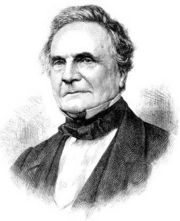查爾斯·巴貝奇
出自 MBA智库百科(https://wiki.mbalib.com/)
查爾斯·巴貝奇(Charles Babbage,1792—1871):科學管理的先驅者,第一臺可編程的機械電腦的設計者
目錄 |
巴貝奇出生於一個富有的銀行家的家庭,曾就讀於劍橋大學三一學院。
- 1812年他協助建立了分析學會,其宗旨是向英國介紹歐洲大陸在數學方面的成就。該學會推動了數學在英國的復興。
- 1814年和1817年先後獲得文學學士和碩士學位。
- 1815—1827年期間在倫敦從事科學活動,1827—1828年期間在歐洲大陸考察工廠。
- 1828—1839年期間在劍橋大學任盧卡斯數學教授(原為伊薩克·牛頓的教席)。
巴貝奇在1812/1813年初次想到用機械來計算數學表;後來,製造了一臺小型電腦,能進行8位數的某些數學運算。1823年得到政府的支持,設計一臺容量為20位數的電腦。它的製造要求有較高的機械工程技術。於是巴貝奇專心從事於這方面的研究。他於1834年發明瞭分析機(現代電子電腦的前身)的原理。在這項設計中,他曾設想根據儲存數據的穿孔卡上的指令進行任何數學運算的可能性,並設想了現代電腦所具有的大多數其他特性,但因1842 年政府拒絕進一步支援,巴貝奇的計算器未能完成。斯德歌爾摩的舒茨公司按他的設計於1855年製造了一臺計算器。使真正的電腦則至到電子時代才製成。
| 影響世界進程的100位管理大師 | ||||||||||||||||||||||||||||||||||||||||||||||||||||||||||||||||||||||||||||||||||||||||||||||||||||
|---|---|---|---|---|---|---|---|---|---|---|---|---|---|---|---|---|---|---|---|---|---|---|---|---|---|---|---|---|---|---|---|---|---|---|---|---|---|---|---|---|---|---|---|---|---|---|---|---|---|---|---|---|---|---|---|---|---|---|---|---|---|---|---|---|---|---|---|---|---|---|---|---|---|---|---|---|---|---|---|---|---|---|---|---|---|---|---|---|---|---|---|---|---|---|---|---|---|---|---|---|
| ||||||||||||||||||||||||||||||||||||||||||||||||||||||||||||||||||||||||||||||||||||||||||||||||||||
| [編輯] |
巴貝奇在24歲時就被選為英國皇家學會會員。他參與創建了英國天文學會和統計學會,並且是天文學會金質獎章獲得者。他還是巴黎倫理科學院、愛爾蘭皇家學會和美國科學學院的成員。
他的主要著作有:
- 《各種人壽保險機構的比較觀點》(1826)
- 《關於科學在英國的衰落及其某些原因的思考》(1830)
- 《對數表樣本》
- 《論機器和製造業的經濟》(1832)
- 《有關徵稅原則的思考、關於財產稅及其免除》(1848)
- 《一個哲學家生涯的片段》(1864)
此外,還有以下一些論文:
- 《機器在數學表計算中的應用》(1822)
- 《論用符號表示機器動作的方法》(1826)
- 《關於調節機器的應用一般原則的論文》(1829)
發明分析機
1823年得到政府的支持,設計一臺容量為20位數的電腦。它的製造要求有較高的機械工程技術。
於是巴貝奇專心從事於這方面的研究。他於1834年發明瞭分析機(現代電子電腦的前身)的原理。在這項設計中,他曾設想根據儲存數據的穿孔卡上的指令進行任何數學運算的可能性,並設想了現代電腦所具有的大多數其他特性,但因 1842 年政府拒絕進一步支援,巴貝奇的計算器未能完成。斯德歌爾摩的舒茨公司按他的設計於1855年製造了一臺計算器。使真正的電腦時至到電子時代才製成。 巴貝奇在24歲時就被選為英國皇家學會會員。他參與創建了英國天文學會和統計學會,並且是天文學會金質獎章獲得者。他還是巴黎倫理科學院、愛爾蘭皇家學會和美國科學學院的成員。
Babbage sought a method by which mathematical tables could be calculated mechanically, removing the high rate of human error. Three different factors seem to have influenced him: a dislike of untidiness; his experience working on logarithmic tables; and existing work on calculating machines carried out by Wilhelm Schickard, Blaise Pascal, and Gottfried Leibniz. He first discussed the principles of a calculating engine in a letter to Sir Humphry Davy in 1822.
Babbage's machines were among the first mechanical computers, although they were not actually completed, largely because of funding problems and personality issues. He directed the building of some steam-powered machines that achieved some success, suggesting that calculations could be mechanized. Although Babbage's machines were mechanical and unwieldy, their basic architecture was very similar to a modern computer. The data and program memory were separated, operation was instruction based, the control unit could make conditional jumps and the machine had a separate I/O unit.
- 差分機(Difference engine)
In Babbage’s time, numerical tables were calculated by humans who were called ‘computers’, meaning "one who computes", much as a conductor is "one who conducts". At Cambridge, he saw the high error-rate of this human-driven process and started his life’s work of trying to calculate the tables mechanically. He began in 1822 with what he called the difference engine, made to compute values of polynomial functions. Unlike similar efforts of the time, Babbage's difference engine was created to calculate a series of values automatically. By using the method of finite differences, it was possible to avoid the need for multiplication and division.
The first difference engine was composed of around 25,000 parts, weighed fifteen tons (13,600 kg), and stood 8 ft (2.4 m) high. Although he received ample funding for the project, it was never completed. He later designed an improved version, "Difference Engine No. 2", which was not constructed until 1989-1991, using Babbage's plans and 19th century manufacturing tolerances. It performed its first calculation at the London Science Museum returning results to 31 digits, far more than the average modern pocket calculator.
- 完成模型(Completed models)
The London Science Museum has constructed two Difference Engines, according to Babbage's plans for the Difference Engine No 2. One is owned by the museum; the other, owned by technology millionaire Nathan Myhrvold, went on exhibit at the Computer History Museum in Mountain View, California on 10 May 2008.The two models that have been constructed are not replicas; until the assembly of the first Difference Engine No 2 by the London Science Museum, no model of the Difference Engine No 2 existed.
- 分析引擎(Analytical engine)
Soon after the attempt at making the difference engine crumbled, Babbage started designing a different, more complex machine called the Analytical Engine. The engine is not a single physical machine but a succession of designs that he tinkered with until his death in 1871. The main difference between the two engines is that the Analytical Engine could be programmed using punch cards. He realized that programs could be put on these cards so the person had only to create the program initially, and then put the cards in the machine and let it run. The analytical engine would have used loops of Jacquard's punched cards to control a mechanical calculator, which could formulate results based on the results of preceding computations. This machine was also intended to employ several features subsequently used in modern computers, including sequential control, branching, and looping, and would have been the first mechanical device to be Turing-complete.
Ada Lovelace, an impressive mathematician, and one of the few people who fully understood Babbage's ideas, created a program for the Analytical Engine. Had the Analytical Engine ever actually been built, her program would have been able to calculate a sequence of Bernoulli numbers. Based on this work, Lovelace is now widely credited with being the first computer programmer.In 1979, a contemporary programming language was named Ada in her honour. Shortly afterward, in 1981, a satirical article by Tony Karp in the magazine Datamation described the Babbage programming language as the "language of the future".
- 現代改編(Modern adaptations)
While the abacus and mechanical calculator have been replaced by electronic calculators using microchips, the recent advances in MEMS and nanotechnology have led to recent high-tech experiments in mechanical computation. The benefits suggested include operation in high radiation or high temperature environments.
These modern versions of mechanical computation were highlighted in the magazine The Economist in its special "end of the millennium" black cover issue in an article entitled "Babbage's Last Laugh".The article highlighted work done at University of California Berkeley by Ezekiel Kruglick. In this Doctoral Dissertation the researcher reports mechanical logic cells and architectures sufficient to implement the Babbage Analytical engine (see above) or any general logic circuit. Carry-shift digital adders and various logic elements are detailed as well as modern analysis on required performance for microscopic mechanical logic.
巴貝奇從小就養成對任何事情都要尋根究底的習慣,拿到玩具也會拆開來看看裡面的構造。以後他又受了數學和其他科學的訓練並考察了許多工廠。這使得他在管理方面提出了許多創見和新的措施。他的貢獻主要有以下幾點:
- 提出了在科學分析的基礎上的可能測定出企業管理的一般原則。他在《論機械和製造業的經濟》一書中指出:“我在過去10年中曾被吸引去訪問英國和歐洲大陸的許多工場和工廠,以便熟悉其機械工藝,在這過程中,我不由自主地把我在其他研究中自然形成的各種一般化原則應用到這些工場和工廠中去。” 這同80年代以後泰羅在《科學管理原理》一書中的下述一段話是很相似的(雖然泰羅並不知道巴貝奇的著作)。泰羅說:“有些人的教育使他們養成了概括併在各處尋找規模的習慣。當這些人碰到了在每一行業中都存在並極為相似的許多問題以後,他們不可避免地試圖把這些問題進行邏輯歸類,並找出解決這些問題的某些規律或規則。”
- 他設計出世界上第一臺電腦。他於1823年設計出來的小型差數——世界上第1台電腦雖然沒有製成,但其基本原理於92年後被應用於巴勒式會計電腦。他還利用計數機來計算工人的工作數量、原材料的利用程度等。他把這叫做“管理的機械原則”。
- 他制定了一種“觀察製造業的方法”。這種方法同後來別人提出的“作業研究的科學的、系統的方法”非常相似。觀察者用這種方法進行觀察時利用一種印好的標準提問表。表中包括的項目有:生產所用的材料,正常的耗費、費用、工具、價格,最終市場,工人、工資、需要的技術,工作周期的長度等。
- 他進一步發展了亞當·斯密關於勞動分工的利益的思想,分析了分工能提高勞動生產率的原因。他指出,這些原因是:
- 節省了學習所需要的時間。生產中包含的工序愈多,則所需要的學習時間愈長。例如一個工人無需從事全部工序而只做其中少數工序或一道工序,就只需要少量的學習時間。
- 節省了學習中所耗費的材料。因為在學習中都要耗費一定的材料。實行勞動分工後,需要學習的內容減少了,所耗費的材料也相應地減少。
- 節省了從一道工序轉變到另一道工序的耗費的時間。而且,由於分工後經常作某一項作業,肌肉得到了鍛煉,就更不易疲勞。
- 節省了改變工具所耗費的時間。在許多手藝中,工具常常是很精細的,需要作精密的調節。調節這些工具所占的時間相當多,分工後就可以大大節省這些時間。
- 由於經常重覆同一操作,技術熟練,工作速度可以加快。
- 分工後註意力集中於比較單純的作業,能改進工具和機器,設計出更精緻合用的工具和機器,從而提高勞動生產率。
巴貝奇還指出,腦力勞動也同體力勞動一樣地可以進行分工。他指出,法國橋梁和道路學校校長普隆尼把他的工作人員分成技術性、半技術性、非技術性3類,把複雜的工作交給有高度能力的數學家去做,把簡單的工作交給只能從事加減運算的人去做,從而大大提高了整個工作的效率。
- 他進行了有關工作時間問題的研究。在這項研究中,他徵得同意後引用了法國庫倫布的觀察材料。這是在管理問題上國際合作的最早範例。
- 在勞資關係方面,他強調勞資協作,強調工人要認識到工廠制度對他們有利的方面。這也同泰羅在幾十年後發表的論點很相似。他提出一種固定工資加利潤分享的制度,認為這種制度有以下的好處:
- 每個工人同工廠的發展和利潤的多少有直接的利害關係;
- 每個工人都會關心浪費和管理不善的問題;
- 能促使每個部門改進工作;
- 鼓勵工人提高技術和品德,表現不好者減少分享的利潤;
- 由於工人同雇主的利益一致,能消除隔閡,共求繁榮。
- 他還探討了能使投資效率更高的大工廠的優越性,以及這些工廠對原料來源的恰當位置;工藝過程和製造成本的分析(如在制針業中);在同一領域中各個企業的比較研究。(如《各種人壽保險機構的比較觀點》)等。









我們要學習他